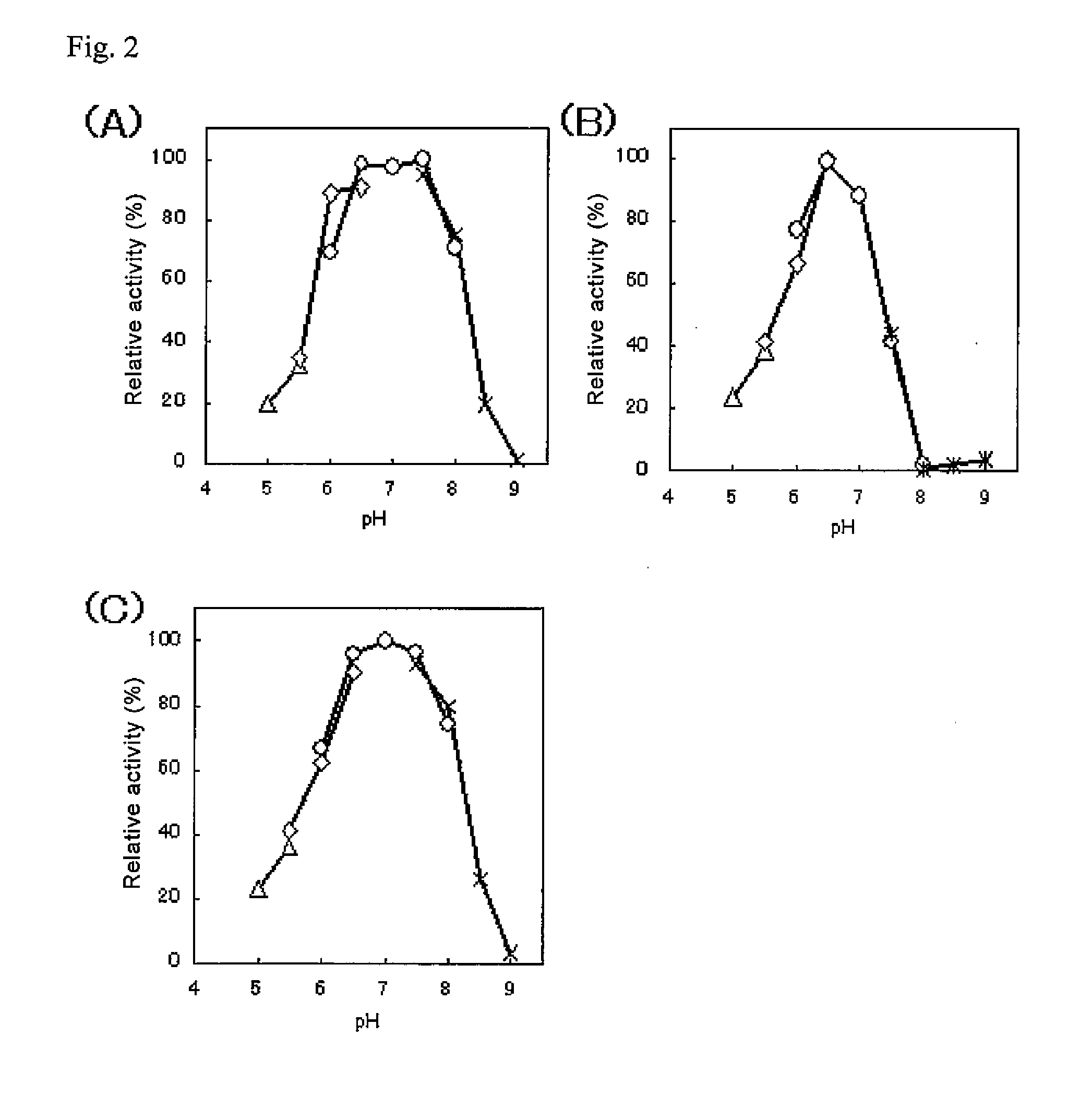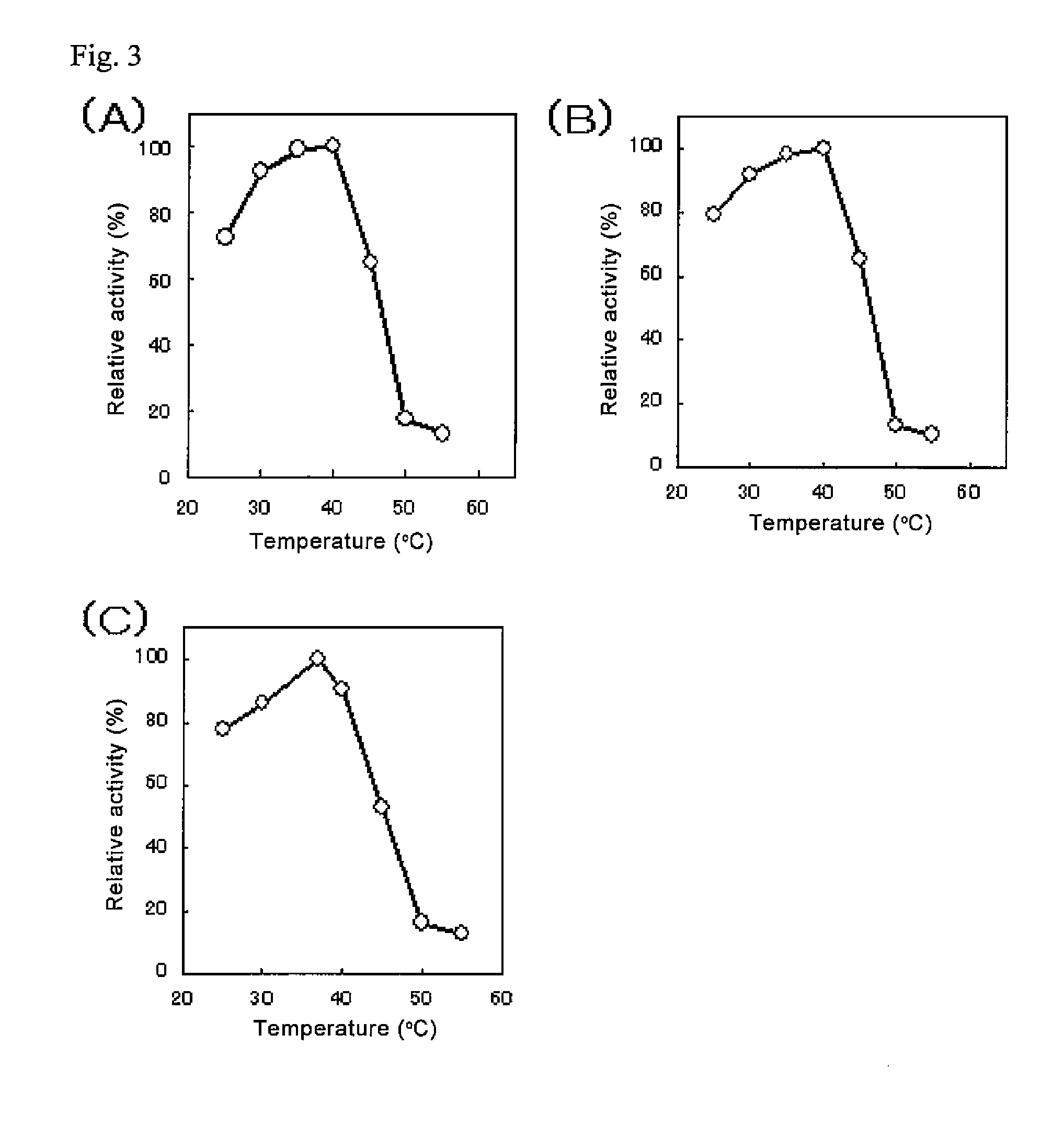Flavin-bound glucose dehydrogenases, a method for producing a flavin-bound glucose dehydrogenase, and yeast transformant used for the same
a technology of flavin-bound glucose and dehydrogenase, which is applied in the field of flavin-bound glucose dehydrogenase, and yeast transformant used for the same, can solve the problems of affecting measurement accuracy, enzyme instability, and sugar compounds other than glucose in a sample, and achieve accurate measurement of blood glucose levels, accurate measurement of d-glucose, and excellent heat resistance
- Summary
- Abstract
- Description
- Claims
- Application Information
AI Technical Summary
Benefits of technology
Problems solved by technology
Method used
Image
Examples
example 1
Acquisition of a Flavin-Bound GDH Derived from Mucor
1. Screening of GDH-Producing Cells
[0074]Strains isolated from natural environments and about 500 stored strains supplied by a culture collection institution (Noda Institute for Scientific Research) were screened for GDH production. Each bacterial strain under test was inoculated into 3 mL of malt extract medium (2.0% malt extract, 2.0% D-glucose, 0.1% polypeptone, pH 6.0), followed by shaking culture at 30° C. for 3-5 days. The culture medium was centrifuged at 800×g for 10 minutes to precipitate cells. Subsequently, the cells were suspended in 10 mM acetate buffer (pH 5.0) and homogenized using a Multi-beads Shocker (Yasui Kikai) (2,000 rpm, 60 seconds, 16 times). The supernatant collected by centrifugation at 20,000×g and 4° C. for 10 minutes was used as a crude enzyme solution.
2. Determination of GDH Activity
[0075]Solutions were mixed according to the following procedures, followed by absorbance measurement to examine GDH acti...
example 2
Purification of a Flavin-Bound GDH Derived from Mucor
[0079]To a 0.5 L Sakaguchi flask, 0.1 L of preculture medium (2.0% yeast extract, 4% glucose, pH 6.0) was added. Into the flask, about 1 cm2 each of a preculture of Mucor prainii NISL0103, Mucor javanicus NISL0111, or Mucor circinelloides f. circinelloides NISL0117 on a plate was inoculated, followed by shaking culture at 130 rpm and 30° C. for two days. This was used as a seed culture. Into 20 L of the above medium in a 30 L jar fermenter (two jar fermenters), 0.2 L each of the seed culture was inoculated, followed by culture at 200 rpm, 30° C., and 0.5 vvm for three days. After the completion of the culture, 40 L of culture medium was filtered through a filter cloth to collect cells. Subsequently, the obtained cells were suspended in 10 mM acetate buffer (pH 5.0).
[0080]The above cells suspension was sent to a Dyno-Mill (150 mL / min) and homogenized. The supernatant was collected by centrifugation at 6,000×g for 30 minutes. This ...
example 3
Investigation of the Enzymatic Properties of Flavin-Bound GDH Derived from Mucor
[0083]The properties of the purified GDHs obtained in Example 2 were investigated.
(a) Measurement of Absorption Spectra
[0084]MpGDH, MjGDH, and McGDH were dialyzed using 10 mM acetate buffer (pH 5.0), followed by the measurement of absorption spectra at 250-800 nm using a spectrophotometer U-3010 (Hitachi High-Technologies Co., Ltd.). FIG. 1 shows the measurement results (FIG. 1 (A), (B), and (C) show the absorption spectra of MpGDH, MjGDH, and McGDH, respectively.). All the GDHs showed two maximal peaks at around 340-350 and 420-430 nm wavelengths, strongly suggesting that the GDHs of the invention are flavin-bound proteins because these absorption spectra are specific to a flavin enzyme.
(b) Measurement of GOD Activity
[0085]MpGDH, MjGDH, and McGDH obtained in Example 2 and a commercial glucose oxidase derived from Aspergillus niger (GOD, biozyme laboratories) were used to measure GDH and GOD activities....
PUM
| Property | Measurement | Unit |
|---|---|---|
| Temperature | aaaaa | aaaaa |
| Fraction | aaaaa | aaaaa |
| Fraction | aaaaa | aaaaa |
Abstract
Description
Claims
Application Information
 Login to View More
Login to View More - R&D
- Intellectual Property
- Life Sciences
- Materials
- Tech Scout
- Unparalleled Data Quality
- Higher Quality Content
- 60% Fewer Hallucinations
Browse by: Latest US Patents, China's latest patents, Technical Efficacy Thesaurus, Application Domain, Technology Topic, Popular Technical Reports.
© 2025 PatSnap. All rights reserved.Legal|Privacy policy|Modern Slavery Act Transparency Statement|Sitemap|About US| Contact US: help@patsnap.com



